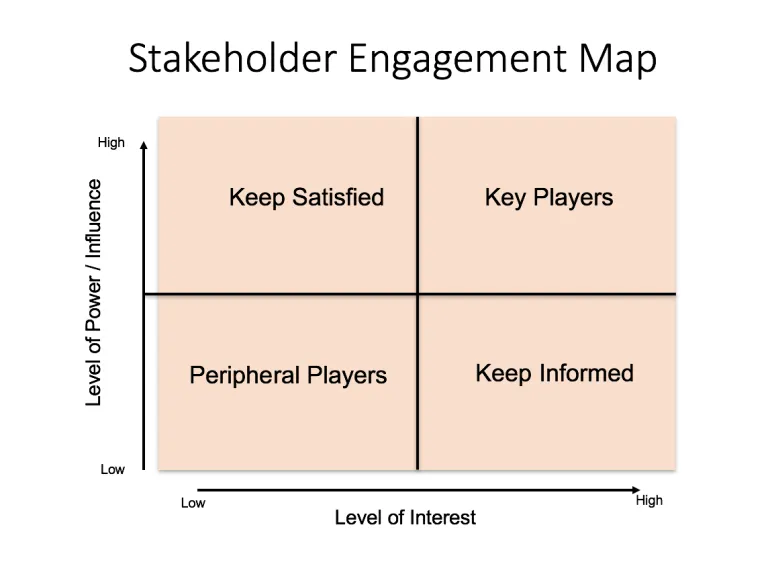In my own leadership journey I have overseen a number of changes for the teams that I have led. These started out as small projects but as the company grew so did the size and scale of the projects. With careful planning most of these changes have been relatively uneventful as far as implementing change goes. However, there have been some hiccups and times when things were more stressful than they needed to be.
While reviewing the difficulties experienced in the projects that caused me the most heartache, a common theme occurred. Despite thorough and detailed technical planning I had spent insufficient time planning stakeholder engagement. Instead I was relying on a small number of generic communication strategies which upon review were not meeting the needs of certain stakeholders. There was a clear need to slow down and assess each individual stakeholder’s needs through a stakeholder engagement map.
Change vs Transition
As part of any change management it is important to recognize the individual psychological process for those affected by such events. Change at an individual level is complex and has 2 key components – Change and Transition.
Change happens for an individual when an external event occurs. This can be the implementation of a new procedure, policy, equipment or technology to name a few. As part of the implementation and the change management process these external events are concrete and often occur simultaneously for all those effected, for example, the implementation dates for a change is often the same for all staff. This makes it easy to see where both individual staff and teams are in the change process (i.e., they are either using the new technology or awaiting roll out).
Transition, on the other hand, relates to the internal psychological process that those effected by change experience. Transition is the process where those affected start to accept the change and it becomes incorporated into their way of viewing the world. Most of us experience a transition to some degree at the beginning of each calendar year. Often we continue to say or write the previous year on correspondence for a while until we ‘transition’ to the new year. Hopefully we succeed before the end of January!
Transition that occurs for those affected by change happens at different rates for each individual. Sometimes this can even start to occur before implementation of a change and other times it can be a prolonged process following implementation. It is therefore not uncommon to have a range of reactions from those affected ranging from little or no transition (sometimes observed as denial, passive aggressive/white anting) through to full transition (adaption and promotion of the change).
With this in mind it is important to spend time creating a stakeholder engagement map to ensure that strategies used throughout the change process maximizes the opportunity to assist with the required transition. If the wrong strategies are used or are absent then stakeholders can feel under informed, not consulted, or even resistant to the change.
Stakeholder Power Engagement Map
Completing a Stakeholder Engagement Map is the best way to assess the needs of each stakeholder in the change process. Some stakeholders will need a lot of information and consultation to assist with their transition and others will require little information or consultation. This is best assessed by determining both the level of interest in a change and the level of power or influence a stakeholder has over a change.
In every change there are Key Players. These are the stakeholders who have both a high level of power/influence while also having a high level of interest in the change that is being undertaken. For example, in the case of a school changing it’s procurement and purchasing systems the Key Players may include the Principle and the Heads of Department. These stakeholders have a high level of power and influence over which functions, reporting and governance is required while also ultimately holding the power as to what will get ‘signed off’ to be implemented. Naturally their level of interest is high given their governance responsibilities in overseeing the running of the school. Strategies need to be developed to assist these stakeholders transition with the change including the appropriate levels of consultation and communication.
Next to consider are the group of stakeholders in the matrix are those that have a high level of power or influence but a low level of interest. The strategies required here are ones to help Keep Satisfied this group of stakeholders. By further exploring each stakeholder within this group, strategies can be identified to map the level and frequency of communication and consultation required to keep these stakeholders satisfied. Just because they fall at the lower end of the interest spectrum does not mean that they should be confused as having no interest. In the example above of the changes to a procurement and purchasing system some of the stakeholders that may fall into this group are the School’s Board, Parent and Citizens Associations or the Education Department (if it is a state run school). These stakeholders are interested in the change as they will want to ensure the school’s money is put to the best use, however the school’s management team is there to handle the details of the change and report back to them on regulatory issues and compliance. However, despite having a lower level of interest in the details than the Principal and their leadership team, this group also has a high level of power and influence. If this group becomes concerned about the change then they are often able to influence or even directly intervene.
There are also those stakeholders who have a high level of interest and a low level of power/influence in the change process. Strategies here need to aim to Keep Informed these stakeholders. Individuals and groups that fall into this category do so because the change will impact on their normal day to day tasks. Therefore, it is critical that appropriate strategies for adequate consultation and communication are considered and implemented with this group to ensure they both contributed but also have a clear understanding of how the change will be implemented. In the example above of the changes to a procurement and purchasing system, some of the stakeholders that may fall into this group are teachers and administration staff. It is important for their input to be considered as part of the consultation as well as receiving detailed communication regarding the implementation and roll out of the change to ensure they can continue to effectively do their job.
Finally, there are the Peripheral Players in the change process. These are the stakeholders who have a low level of power/influence over the process and also a low level of interest in the details of the change process. With this group of Stakeholders, it is important to ensure that an adequate level of communication is used to ensure that they are able to transition to the new change with minimal disruption. These are often external or peripheral internal stakeholders for whom the change will have minimal impact on their day-to-day work. In the example above of the changes to a procurement and purchasing system, some of the stakeholders that may fall into this group are the Auditors and Suppliers.
By taking the time to explore the different needs of each of these groups within the stakeholder matrix leaders can increase their likelihood of effectively implementing Change. By better understanding and matching engagement and communication strategies to the needs of each of the stakeholder groups, leaders are able to reduce barriers and resistance that is often encountered when stakeholder’s needs are not addressed.
Tips for Effectively Engaging Stakeholders in Change Management
- Create a list of all stakeholders, internal and external, that are affected by the Change being introduced.
- Map the list of stakeholders onto the engagement map (above) according to their level of power/influence over the change process and their level of interest in the change process.
- For each of the stakeholders generate an engagement strategy detailing the appropriate level of consultation, the depth and level of information required as well as the frequency and medium (i.e., face to face, email, factsheets) of communication etc.
Stay Ahead Of The Curve!
Ben De Young
The Performance Curve


